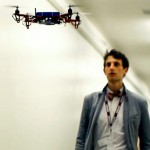The post Positive Space in Photography: A Guide appeared first on Digital Photography School. It was authored by Megan Kennedy.

As a photographer, you may have heard of negative space, which refers to the more subtle areas surrounding the main subject in a photograph. However, positive space, the populated or focal point of an image, is a term that tends to fly under the radar.
In this article, we’ll take a look at positive space in composition and how you can use it to improve your photos.
What is positive space in photography?
Positive space refers to the subject matter or areas of peak interest in a photograph. It’s the key component of almost every great photo.
That said, like all compositional elements in photography, positive space is influenced by other aspects of a photo. Perhaps one of the most significant of these aspects is negative space – positive space is often sculpted by negative space and vice versa. You see, when photographing a clear subject, there is usually “occupied” or positive subject matter contrasted with negative elements that are not key focal points. Therefore, when discussing positive space, it’s hard not to mention the role of negative space, too.

While positive space may constitute the main show, negative space serves as the stage. And although the word negative seems to imply a lack of content, the term doesn’t just refer to areas completely devoid of subject matter. In fact, negative space only has to be visually quieter, less populated, more subtle, or restful compared to the main subject.
A brief history of positive space
Positive space – and the interaction of positive and negative space – has been used in art throughout history. Painters, sculptors, architects, potters; all have balanced positive and negative dynamics to allow for tactical areas of visual rest, rhythm, focus, activity, atmosphere, etc.
For example, negative space in traditional Japanese art styles is often embraced to accentuate or balance the weight of the expressive and spontaneous brushstrokes that constitute positive subject matter.
Another example is Edgar Degas’s careful use of negative space in his scenes depicting ballet dancers. The negative space imbues the photos with a greater sense of movement, context, and contrast, creating interesting juxtapositions and framing detail.
With the invention of photography, the artistic possibilities of positive and negative space expanded to the photographic image. From Anna Atkins, Henri Cartier-Bresson, Dorothea Lange, and Robert Frank to Diane Arbus, Hiroshi Sugimoto, Steve McCurry, and Didier Massard, photographers have used negative space to support key (positive) focal points.
Why is positive space important?
Positive space matters because it can steer the narrative of an image or draw a viewer’s eye. Without positive space, negative space often looks directionless. In turn, a photograph lacking negative space may seem crowded or overwhelming.
Positive space creates momentum, narrative, and visual climax. Negative space can provide context, emphasis, isolation, and breathing room, funneling the viewer’s eye toward positive space and allowing the focal point to flourish.

Canon 5D Mark IV | Canon EF 50mm f/1.8 II with extension tubes | f/2.8 | 1/250s | ISO 100
Working with positive space: the basics
There are many ways to approach photographing positive space. Here’s what I recommend to get started:
- First, identify the positive areas of the scene – the elements of the composition that immediately stand out.
- Next, evaluate the negative space (you can use the viewfinder or your LCD for this). What does the negative space do? Does it uphold the positive space? Does it add context? Depth? Atmosphere? Narrative? Beauty?
- Finally, consider the technical aspects of your photo, and how they might affect positive and negative space. For example, adjusting the aperture will create a shallow or deep depth of field, where a shallower depth of field will often create more negative space.
These basic considerations will help you improve your use of positive space.

Advanced tips and techniques for working with positive space
If you want to take your compositions to the next level, here are a few tips and tricks to help capitalize on positive space:
Tip 1: Apply compositional techniques
Positive space is a fundamental part of photographic composition, but it doesn’t exist in isolation. It can work alongside other compositional techniques, such as leading lines, depth of field, framing, symmetry, and perspective, to create beautiful photos.
So the next time you’re out with your camera, think about positive space. And also think about how you can use positive space in conjunction with composition principles to get the most impactful results.

Tip 2: Be mindful of both negative and positive space
The key to striking a successful positive/negative balance (or intentional imbalance) often lies in awareness. When composing a photograph, make sure you carefully check the negative space that surrounds a positive space, and ask yourself whether it works as it is – or whether it needs to be modified.
(A quick visual scan through the viewfinder or on the digital screen is a small action that can save time and many wasted shots!)

Furthermore, when framing a subject, running through a quick checklist can be helpful. Ask yourself: What is the negative space contributing? What is the positive space contributing? Does the positive space benefit from the negative regions that surround it?
Briefly pausing to consider the positive/negative dynamics in a photograph can increase the chances of capturing a successful image.
Tip 3: Use your camera settings
Positive space can hinge on negative space that occurs naturally (i.e., the sky, shadows, etc.), or on negative space that is deliberately created through camera settings.
For example, in a busy urban environment, a slow shutter speed can blur the flow of traffic to create negative space (and this will, in turn, emphasize static subjects like buildings and sculptures that constitute positive areas of interest).
ICM (intentional camera movement) can sometimes create blurry and abstract negative areas that highlight positive focal points. Selective focus can emphasize or deemphasize visually positive areas, and by adjusting the aperture settings, you can blur the background and/or foreground surrounding a positive subject. Zooming in or out in-camera or cropping with post-production can also manipulate the dynamics of positive and negative space.
In other words:
If you want more negative space, you can create it yourself! Just tweak your camera settings to achieve the effect you’re after.

Tip 4: Know your narrative
Like all compositional tools, positive space can evoke emotions and tell stories. By determining your narrative in advance, you can use positive and negative space to create an impactful, coherent image.
For example, a smaller positive subject set within a large amount of negative space can evoke a sense of scale, isolation, simplicity, grandiosity, and distance. Negative space in the form of a bold, dark vignette can frame a positive subject for added impact. An image with predominantly positive space can generate immediacy and energy. Evenly distributed positive and negative space can lend to the impression of harmony and balance.
(The list goes on!)
Tip 5: Experiment!
Any positive (and negative) space bends to an endless amount of compositional variables. Experimenting with creative techniques, subjects, and conditions broadens the creative potential of any positive subject.
And although the term “negative” suggests “nothingness,” negative space, as we have seen, is just as versatile and important as its positive counterpart.
So while experimenting with positive space through the mindful manipulation of negative space can be a balancing act, gaining a good grasp on both forms of space will result in the best photos overall.

A guide to positive space: conclusion
Positive space is a critical part of photographic composition. While the discussion of negative space is more common, positive space is the driving force behind countless photographic images.
Consciously working with positive space encourages a greater connection with the subject matter, and it’ll also help you create better compositions.
Now over to you:
Do you have any favorite ways to work with positive space? How do you balance positive and negative space? Share your thoughts (and images!) in the comments below!
The post Positive Space in Photography: A Guide appeared first on Digital Photography School. It was authored by Megan Kennedy.
















You must be logged in to post a comment.